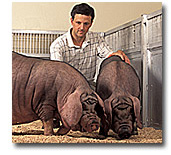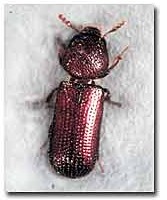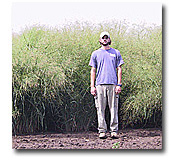|

An Overview of NPA Research Successes!
(Taken from a 2007 presentation by Bryan Kaphammer, Ph.D., NPA Tech Transfer Coordinator)
Precision Ag | Precision Ag Models | Cropping Systems | Genomics | High Impact Varieties | Solutions for Pests & Disease | BioControl | Nutrition | Storage | Biofuels | And there's more!
With 14 active patents, 18 active licenses worth nearly a half million dollars and more than 200 material transfer agreements in the works, researchers in the Northern Plains Area continue to make new discoveries everyday of benefit to American agriculture. NPA research touches everyone whether you’re an agricultural producer interested in new profitable crop rotation strategies; an ag industry agent looking for ways to reduce pest impacts in stored grain, or an ordinary consumer looking to improve your nutrition level.
Outlined below are just a sampling of the many research successes and promising projects underway in the NPA, organized under the following broad categories. (Note: The locations coordinating those research efforts are listed in parentheses.)
"Research Excellence: Meeting Customer Expectations"
Precision Ag

• Use of proper cover crops can increase potato production by 1500 lbs/acre. (Fort Collins)
• New irrigation technology for sugar beets to minimize chemical runoff and conserve water. (Sidney)
• Software for Center Pivot Evaluation and Design. (Fort Collins)
• Remote sensing to aid in nutrient application (Lincoln)
• Software and technology for weed management (Fort Collins)
Back to top
Precision Ag Models

(Note: For more information on these and other NPA research software and information products please see our NPA Products and Services page.)
• GPFARM is now being distributed by the Colorado Wheat Growers to their membership. Currently, we have two CRADAs to expand GPFARM’s application. (Fort Collins)
• The Root Zone Water Quality Model recently won both an ARS and national FLC Technology Transfer Award. The model is used by the EPA to regulate new chemical registration, and chemical companies using this model when preparing EPA applications have saved millions of dollars. (Fort Collins)
• The Wind Erosion Prediction System (WEPS) is currently completing testing with NRCS. This system will become the major tool NRCS uses in administering its wind erosion control program. (Manhattan)
Back to top
Cropping Systems

New crop rotation and management strategies have greatly improved yields and profitability of NPA farms.
• Strip till technology for sugar beets dramatically reduces trips across the field and subsequent fuel costs. (Sidney)
• Getting away from the wheat fallow rotation in eastern Colorado has increased profitability as much as three times. (Akron)
• Mandan’s Crop Sequence Calculator helps maximize profitability while protecting and preserving the environment. It has become an important tool for Northern Plains farmers. (Mandan)
Back to top
Genomics in the NPA

• NPA scientists are leading the way in genomics from the thistle Cirsium genome (Fargo) to identify new weed control strategies and the red flour beetle genome (Manhattan) to identify candidate genes for insect control, to DNA markers in sheep (Clay Center) for identification of scrapies resistance.
• In cattle, the genomics project lead by Clay Center and Miles City scientists and others around the country/world has resulted in identification of genes for meat tenderness and growth. These data are also being used to optimize breeding through marker assisted selection technology developed at ARS. Beef cattle producers keep track of characteristics of their animals to selectively breed them and improve specific traits. But breeding for one trait can cause potential problems with others. ARS’ technology allows the breeder to take into account many traits in their breeding strategy, resulting in broad gains in productivity.
• The pig genome is currently being sequenced, so the advances already seen in cattle will soon be realized in swine. (Clay Center)
• In today’s uncertain world it is more important than ever to protect agriculture’s genetic resources. This is the mission of the National Center for Genetic Resources Preservation. The diversity of this preservation effort is amazing. From garlic and grapes to rare sheep, cattle, and even insects, the preservation program is strategic to the U.S. agricultural community and the cornerstone of ARS research and research around the world. (Fort Collins)
Back to top
High Impact Varieties

• ARS has a history of supplying the US agricultural community with elite germplasm and varieties and NPA scientists are a big part of that history. From easy to establish and nutritional forage varieties (Logan) and forage sorghum (Lincoln) to new varieties of white wheat (Lincoln), that could open export markets to US farmers to herbicide and white mold resistant sunflower (Fargo), the US farm would not be nearly as productive if it was not for the efforts of NPA scientists.
Back to top
Solutions for Pests and Disease

NPA scientists provide a great deal of technology to combat pests and disease, including:
• Sugar beet germplasm resistant to fungal rot (Fort Collins), new sources of resistance to head blight and tan spot in wheat (Fargo), as well as evaluation of corn rootworm resistant transgenic corn. (Brookings)
• NPA scientists are also hard at work identifying vectors for animal diseases like vesicular stomatitis virus. This information will help scientists devise control strategies. (Laramie)
Back to top
Biocontrol

• Biological control can be a safe and effective means of controlling invasive weeds and damaging insects. NPA scientists have identified and in some cases successfully deployed biocontrol agents such as flea beetles that eat leafy spurge, Chinese leaf beetles that attack saltcedar, and Metarhizium fungi that attack grasshoppers, bee mites and sugarbeet root maggots. (Sidney)
Back to top
Nutrition

• The reason food is grown is to be consumed. For nutrients to have value they must be absorbed. NPA human nutrition research helps us understand the form in which micronutrients like zinc and iron are best absorbed. The best way to get your micronutrients is through foods rich in them, but if you do take supplements make sure you take them in the form that will result in maximum absorption. (Grand Forks)
Back to top
Storage of Ag Products

• Agricultural products generally need to be stored. NPA scientists are developing methods of storing potatoes to minimize sprouting (Fargo) and grain storage and monitoring technology to minimize insect damage to small grains (Manhattan). Insect damage results in millions of dollars in lost grain each year. ARS’ technology has greatly reduced these losses.
Back to top
Biofuels

• ARS has been working in biofuels long before it was cool. ARS scientists outside of NPA are working on the ethanol and biodiesel processes, while NPA scientists are developing new varieties of switchchgrass, the raw material for cellulosic ethanol. These new switchgrass varieties produce 15% more biomass than current varieties. They are also developing low lignin varieties, which will facilitate maximum conversion of the cellulose to ethanol. (Lincoln)
• Ethanol production also results in waste products that can be used for animal feed. NPA scientists are developing economic methods for handling and converting that waste into feed. (Brookings)
Back to top
And there’s more!
As evident above, the diversity of research in the NPA and its impact is tremendous! Here are just a few final examples to further demonstrate that point:
• NPA researchers have developed alternative pollination strategies using blue orchard bees, which when applied properly have been shown to make a marginal cherry producer the largest producer in the county, without the addition of new trees. (Logan)
• Researchers have also developed monoclonal antibodies for detection of chemical residues, like ractopamine, in agricultural products, which has been a big hit with industry. Many companies now turn to ARS to develop detection systems. This is one of the NPA’s biggest licensing success stories. (Fargo)
• In food safety, ARS’ carcass cleaning technology has saved the beef industry millions each year and helps instill confidence in the American consumer that U.S. Beef is safe. (Clay Center)
Back to top
|